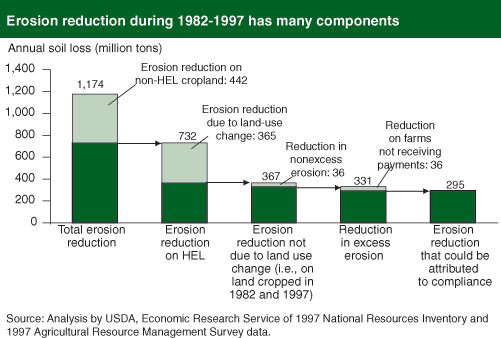Conservation Compliance May Reduce Soil Erosion
- by Roger Claassen
- 7/1/2006
Between 1982 and 1997, the annual rate of soil erosion on U.S. cropland declined from 3.1 billion tons to 1.9 billion tons—a reduction of 1.2 billion tons per year, or about 40 percent. Of the 1.2-billion-ton drop in annual cropland soil erosion, 732 million tons occurred on highly erodible cropland (HEL). During the same period, USDA phased in a requirement designed to reduce erosion on HEL. Conservation compliance requires farmers who crop HEL to apply an approved soil conservation system or risk losing most agriculture-related Federal payments, including farm income support. Though these reductions coincide with the 10-year phase-in of conservation compliance, not all of the erosion reduction can be attributed to program requirements.
By breaking down the 732 million tons of erosion reduction into components, ERS researchers identified the portion that could be attributed to conservation compliance. First, about 365 million tons—roughly 50 percent—of erosion reduction on HEL cropland occurred on land that was cropped in 1982 but not in 1997. Because conservation systems were designed to maintain the viability of crop production, erosion reduction due to land use change was not likely to stem from conservation compliance. Excluding these erosion reductions leaves 367 million tons.
Second, conservation compliance requires farmers to eliminate only “excess” soil erosion—erosion deemed to be damaging to soil productivity. Typically, excluding the 36 million tons of nonexcess erosion (reduction to levels less than 5 tons/acre/year) leaves 331 million tons.
Finally, erosion reduction can be attributed to compliance only if it occurred on a farm that receives farm program payments. Thirty-six million tons are estimated to have occurred on farms not receiving payments. The remaining 295 million tons of erosion reduction—25 percent of the total—are estimated to have occurred in the context of the conservation compliance requirement.
It is not certain whether these erosion reductions can be attributed to conservation compliance. Soil erosion was also reduced on non-HEL, which is not subject to conservation compliance. Erosion reductions could also be attributed, at least in part, to the development of less erosive farming systems. For example, the development of machinery that allows planting crops directly into minimally tilled or untilled fields can reduce both costs and soil erosion. However, even if these farming systems would have eventually been adopted by many farmers, conservation compliance may have prompted faster and broader adoption.
This article is drawn from:
- Claassen, R., Breneman, V., Bucholtz, S., Cattaneo, A., Johansson, R. & Morehart, M. (2004). Environmental Compliance in U.S. Agricultural Policy: Past Performance and Future Potential. U.S. Department of Agriculture, Economic Research Service. AER-832.


